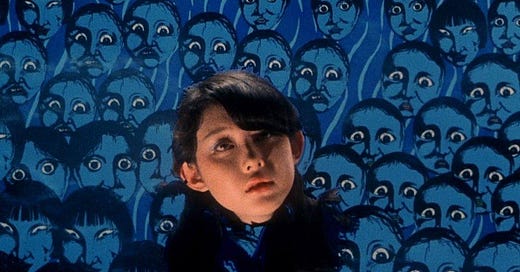Directed by Nobuhiko Obayashi
Japan, 1977
If Kurosawa or Ozu were to see it … what kind of direction would offend them most?
This was Japanese director, Nobuhiko Obayashi, talking about his 1977 cult classic, House. Produced by the Toho Film Studios, who brought us Godzilla, House was made two years after Obayashi wrote the script. None of the studio directors would go near it, as it looked like career suicide, so Obayashi was allowed to step in and direct his debut feature film. He was supposed to be making a Japanese crowd-pleasing horror in the style of Spielberg’s recently released Jaws.
This film bears no resemblance to Jaws but what we do have is the most bizarre, absurd, colourful, and awful (in both the ancient and modern sense) film that ReidsonFilm has seen in a long time. If you put the Beatles’ Yellow Submarine and Dario Argento’s Suspiria in a blender you might end up with something like House.
I wanted to make a film unlike any Japanese film before it - Nobohiku Obayashi
The plot itself is pretty pedestrian. An adolescent schoolgirl – ‘Gorgeous’ or ‘Angel’ depending which subtitled print you watch – decides to visit her frail and elderly aunt who lives in a house in the countryside. It’s the summer holiday and school is out so she takes along six of her classmates. The house turns out to be haunted and there is no shark to be found.
However, even before they set off for the supernatural horror house we are already drowning in a sea of erratic editing, repeating jump-cuts and psychedelic visuals. The primary determinant for this is that Obayashi brought in his 10 year old daughter, Chigumi (now an actor and director in her own right) as a co-writer – she gets a credit – and harnessed her imagination to drive the story and translate it to the screen.
First things first, the audio mix was terrible. The film opens with blaring 70s pop - ‘Cherries were made for eating’!! - drowning out the dialogue. Much of the acting is amateurish (to be fair, a number of the cast were non-professional) and at times the script sounds like it was made up on the spot but that in itself adds to House’s child’s-eye perspective.
I thought I had a migraine but then I realised the coloured spots and flashing lines were all on screen - S
Presumably taking a lead from Snow White the seven girls are named after aspects of their personality or appearance so we have Prof, the clever one; Melody, the musical one; Kung Fu is self-evident, and then there is Mac who has a big appetite – so her name is short for ‘stomach’. With the exception of Angel’s aunt the adult characters have marginal roles: the leading man, the expected hero, unexpectedly turns into a pile of bananas. Yes, it is that weird.
Obayashi really does throw everything but the kitchen sink at House when it comes to visual effects: iris shots, green screen, double exposure, and we even get some rotoscope animation. Many of the effects don’t actually work but that only adds to the apparently deliberate atmosphere of chaos.
There are the sorts of visual gags – reminiscent of the silent film era – that we see so little of these days. The editing and art direction certainly prefigure MTV and some of those wackier 80s kids TV shows. If you have seen the third season of Twin Peaks you’ll recognise the floating limbs and fractured faces (Eraserhead was released in the same year) and the multi-Oscar-winning yawn-fest Everything Everywhere All at Once owes Obayashi a huge debt.
Perhaps there was a subtext that we were missing? The house had a Grimms’ Fairy Tales atmosphere and many of the tropes and motifs apparently come from Japanese folklore. Obayashi grew up in Hiroshima and in later interviews spoke about the traumatic effect of the atom bomb and its aftermath. Sepia-toned flashbacks in House tell the story of a woman losing her lover in WWII and the multiple body parts flying around the screen could be read as the violence rendered by nuclear war. A psychodynamic take would see Prof, Sweet, Kung Fu & Co. as aspects of a fragmented self that Angel has to integrate as she negotiates the path to adulthood.
But no … we’ll stick with the bloodthirsty piano, malevolent Auntie dancing with a skeleton, and the genuinely melancholic sight of one of the girls trapped forever in the workings of a grandfather clock. House is pure, bubblegum cinema.
Reids’ Results (out of 100)
C - 55
T - 65
N - 60
S - 63
Thank you for reading Reids on Film. If you are new to our reviews do take a look at our back catalogue:
And if you enjoyed it please share with a friend and do leave a comment.





I liked this film much more than you did, apparently.
Sorry guys, the critique is superb, but you have not convinced me to watch this!